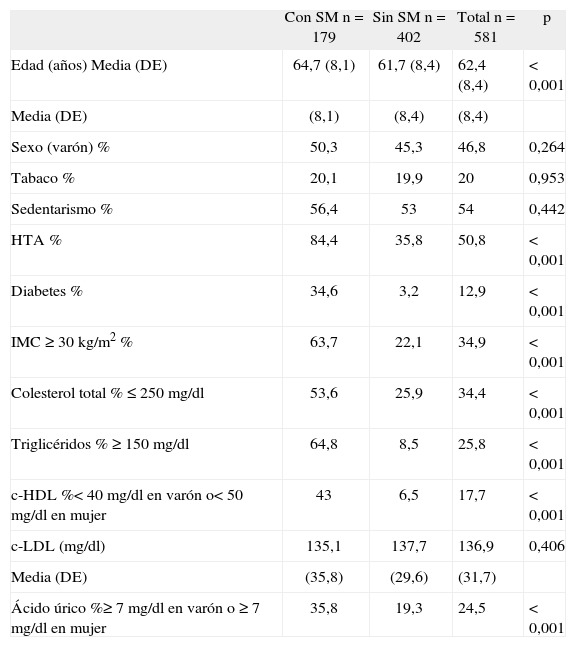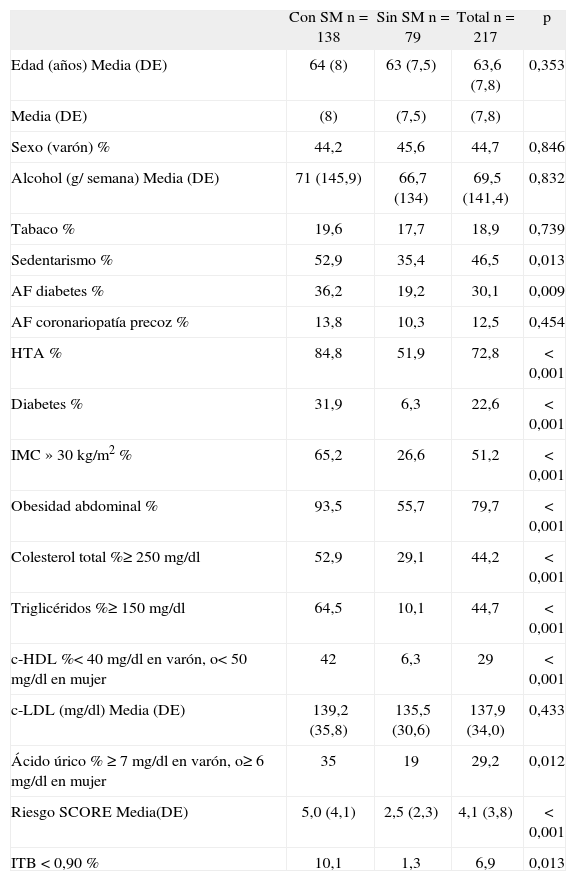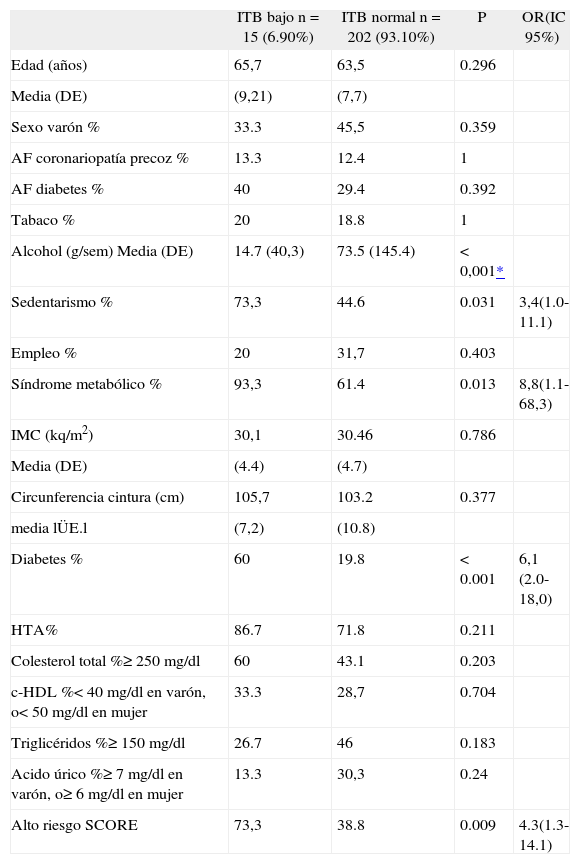El objetivo fue investigar la prevalencia del síndrome metabólico (SM), su riesgo cardiovascular (RCV) y su asociación con la enfermedad arterial periférica (EAP), definida por un índice tobillo-brazo (ITB) bajo (< 0,90), en prevención primaria.
Material y métodosEstudio transversal, realizado en población general de Atención Primaria, de 50-79 años. EL RCV y el ITB se midieron en los casos de SM sin enfermedad arterial conocida y en un grupo control sin SM. El SM se definió según el Adult Treatment Panel III. El RCV fue estimado mediante el Systematic Coronary Risk Evaluation (SCORE).
ResultadosSe incluyeron 581 sujetos. La prevalencia de SM fue del 30,8% (intervalo de confianza [IC] del 95%: 27,0-34,5). Para el estudio del RCV y el ITB se incluyeron 217 sujetos (138 con SM y 49 con diabetes). En los pacientes con SM el RCV medio resultó alto (5%) y dos veces mayor al de los pacientes sin SM. El ITB fue bajo (< 0,90) en 15 sujetos (6,9% [IC del 95%]: 3,5-10,2), con mayor frecuencia en el grupo SM: 14 casos (10,1%) frente a un caso (1,3%). La frecuencia de ITB bajo en pacientes con y sin diabetes fue del 18,3% y del 3,6% respectivamente. El ITB bajo se asoció con SM, diabetes, sedentarismo, alto riesgo SCORE y con un menor consumo de alcohol. En el análisis multivariante la asociación SM/ITB bajo presentó odds ratio = 14,7 (IC del 95%: 1,7-123,6).
ConclusiónEl SM se asocia a EAP asintomática, por lo que se aconseja medir el ITB en los pacientes que padecen este síndrome.
The objective was to investigate the prevalence of metabolic syndrome (MetS), its cardiovascular disease (CVD) risk and its association with peripheral arterial disease, defined by a low ankle-brachial index (ABI) (< 0.90), in primary prevention.
Material and methodsCross-sectional study performed in the primary care general population, aged 50-79 years. CVD risk and ABI were measured in persons without known arterial disease with MetS and in a control group. MetS was defined by Adult Treatment Panel III. CVD risk was estimated using the Systematic Coronary Risk Evaluation (SCORE).
ResultsA total of 581 subjects were recruited. The prevalence of the metabolic syndrome was 30.8% (95% confidence interval [CI], 27.0-34.5). For the CVD risk and ABI studies 217 individuals were included (138 with MetS and 49 with diabetes). Average CVD risk was high (5%) on patients with MetS and twice as much as those without MetS. ABI was low (< 0.90) on 15 subjects [6.9% (95% CI), 3.5-10.2], with higher frequency in the MetS group: 14 patients (10.1%) vs 1 patient (1.3%). The frequency of low ABI in patients with and without diabetes was 18.3% and 3.6% respectively. Low ABI was associated to MetS, diabetes, inactivity, high risk of SCORE and less alcohol habit. In the multivariate analysis, the odds ratio for the association MetS/low ABI was 14.7 (95% CI, 1.7-123.6).
ConclusionMetS is related to asymptomatic peripheral arterial disease. Thus, the measure of ABI in those patients with this syndrome is recommended.
Article
Diríjase desde aquí a la web de la >>>FESEMI<<< e inicie sesión mediante el formulario que se encuentra en la barra superior, pulsando sobre el candado.

Una vez autentificado, en la misma web de FESEMI, en el menú superior, elija la opción deseada.

>>>FESEMI<<<








